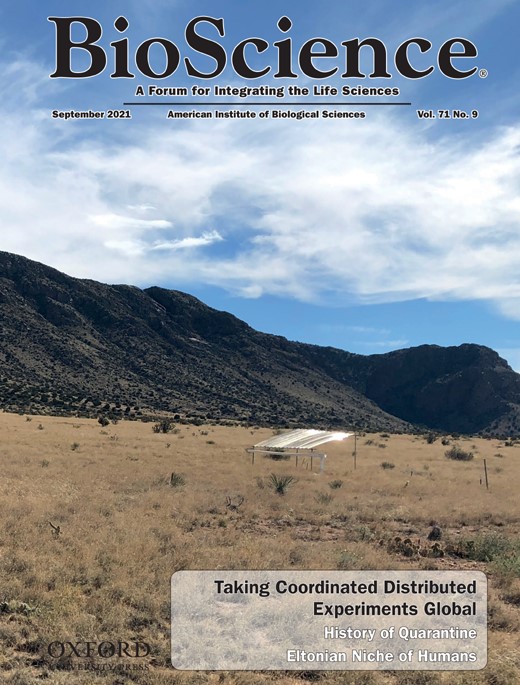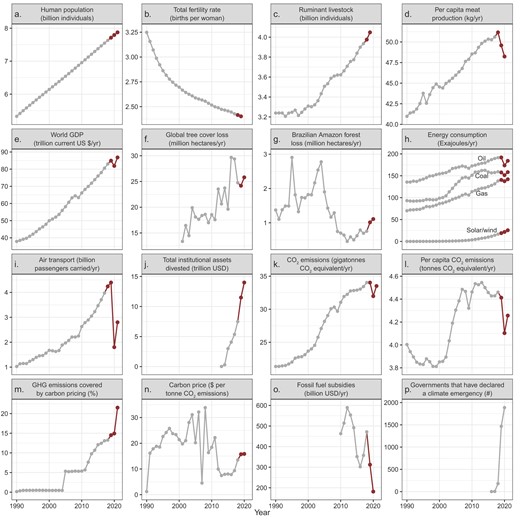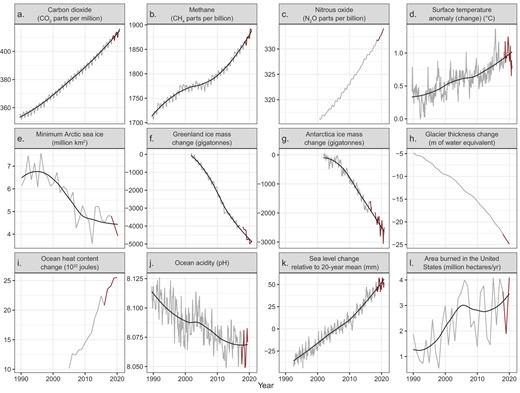-
PDF
- Split View
-
Views
-
Cite
Cite
William J Ripple, Christopher Wolf, Thomas M Newsome, Jillian W Gregg, Timothy M Lenton, Ignacio Palomo, Jasper A J Eikelboom, Beverly E Law, Saleemul Huq, Philip B Duffy, Johan Rockström, World Scientists’ Warning of a Climate Emergency 2021, BioScience, Volume 71, Issue 9, September 2021, Pages 894–898, https://doi.org/10.1093/biosci/biab079
Close - Share Icon Share
In 2019, Ripple and colleagues (2020) warned of untold suffering and declared a climate emergency together with more than 11,000 scientist signatories from 153 countries. They presented graphs of planetary vital signs indicating very troubling trends, along with little progress by humanity to address climate change. On the basis of these data and scientists’ moral obligation to “clearly warn humanity of any catastrophic threat,” they called for transformative change. Since the article's publication, more than 2,800 additional scientists have signed that declaration of a climate emergency (see supplemental file S1 for the current signatory list); in addition, 1,990 jurisdictions in 34 countries have now formally declared or recognized a climate emergency (figure 1p). But, at the same time, there has been an unprecedented surge in climate-related disasters since 2019, including devastating flooding in South America and Southeast Asia, record shattering heat waves and wildfires in Australia and the Western United States, an extraordinary Atlantic hurricane season, and devastating cyclones in Africa, South Asia, and the West Pacific (see supplemental file S2 for attribution information). There is also mounting evidence that we are nearing or have already crossed tipping points associated with critical parts of the Earth system, including the West Antarctic and Greenland ice sheets, warm-water coral reefs, and the Amazon rainforest (supplemental file S2). Given these alarming developments, we need short, frequent, and easily accessible updates on the climate emergency.
Time series of climate-related global human activities. In panels (a), (d), (e), (i), and (m), the most recent data point(s) are a projection or preliminary estimate (see the supplemental material); in panel (f), tree cover loss does not account for forest gain and includes loss due to any cause. With the exception of panel (p), data obtained since the publication of Ripple and colleagues (2020) are shown in red. In panel (h), hydroelectricity and nuclear energy are shown in figure S1. Sources and additional details about each variable are provided in the supplemental material. Complete time series are shown in supplemental figure S2.
Recent trends in planetary vital signs
In the present article, we investigate recent changes in planetary vital signs since the publication of Ripple and colleagues (2020). Out of the 31 variables that we track, we found that 18 are at new all-time record lows or highs (supplemental table S1). Below are noteworthy recent patterns in potential climate drivers (figure 1) and impacts (figure 2):
Food. For the first time, world ruminant livestock numbers soared past 4 billion, which represents much more mass than all humans and wild mammals combined (figure 1c). However, recent per capita meat production (figure 1d), declined by about 5.7% (2.9 kilograms per person) between 2018 and 2020, likely because of an outbreak of African swine fever in China that reduced the pork supply. Future declines in meat consumption and production will probably not happen until there is a general shift to plant-based diets or increases in the use of meat analogs (substitutes), which are growing in popularity and projected to be worth US$3.5 billion globally by 2026 (MarketsandMarkets 2020).
Amazon forest. The Brazilian Amazon annual forest loss rate increased in 2019 and 2020, reaching a 12-year high of 1.11 million hectares destroyed (figure 1g). The increase was likely because of weakening deforestation enforcement triggering a sharp spike in illegal land clearing for cattle and soy farming (Junior et al. 2021). Forest degradation due to fires, drought, logging, and fragmentation has caused this region to act as a carbon source rather than a carbon sink (Qin et al. 2021).
Climate economics. Global gross domestic product dropped by 3.6% in 2020 in response to the COVID-19 pandemic, but it is now projected to be at an all-time high (figure 1e). There was a strong increase in fossil fuel divestment; it increased by US$6.5 trillion between 2018 and 2020 (figure 1j), while, at the same time, fossil fuel subsidies dropped to a record low of US$181 billion in 2020—a 42% decline from 2019 levels—likely because of reduced energy use and prices (figure 1o). The percentage of greenhouse gas emissions covered by carbon pricing is projected to increase from 14.4% to 23.2% between 2018 and 2021 (figure 1m). Much of this increase is due to a proposed carbon pricing scheme by China, which is still rapidly building many coal plants and is now responsible for more emissions than the entire developed world (supplemental table S2; Rhodium Group 2021). The global emissions-weighted average price per tonne of carbon dioxide has remained too low (US$15.49 as of 2020), and it would need to increase severalfold to be highly effective in curbing fossil fuel use (figure 1n).
Energy use. Likely because of the COVID-19 pandemic, fossil fuel energy consumption has decreased since 2019, along with carbon dioxide emissions, per capita emissions of carbon dioxide, and air transport (figure 1h, 1i, 1k, 1l). However, these declines appear to be transient in that 2021 projected estimates show all of these variables significantly rising again. Conversely, solar and wind power consumption increased by 57% between 2018 and 2021, but it is still roughly 19 times lower than fossil fuel consumption (figure 1h). The number of air transport passengers dropped by a sizable 59% in 2020 because of COVID-19, but more than a third of this loss is projected to be recovered in 2021 (figure 1i).
Greenhouse gases and temperature. Three important greenhouse gases, carbon dioxide, methane, and nitrous oxide, all set new year-to-date records for atmospheric concentrations in both 2020 and 2021 (figure 2a–2c). In April 2021, carbon dioxide concentration reached 416 parts per million, the highest monthly global average concentration ever recorded. The year 2020 was the second hottest year on record, and all five of the hottest years on record have occurred since 2015 (figures 2d and S3d).
Melting ice. Greenland and Antarctica recently showed new year-to-date all-time record low levels of ice mass (figure 2f, 2g). In 2020, the minimum summer Arctic sea ice was at its second smallest extent on record, and glacier thickness also set a new all-time low (figure 2e, 2h). Glaciers are melting much faster than previously believed; they are losing 31% more snow and ice per year than they did just 15 years ago (Hugonnet et al. 2021).
Ocean changes. Both ocean heat content and sea level set new records (figure 2i, 2k). Ocean pH reached its second lowest year-to-date average value on record, just behind 2012 (figure 2j). This is troubling given that coral resilience to ocean acidification is likely reduced by thermal stress and more than 500 million people depend on coral reefs for food, tourism, or tropical storm surge protection (Hoegh-Guldberg 2011).
Time series of climate-related responses. Data obtained before and after the publication of Ripple and colleagues (2020) are shown in gray and red respectively. For variables with relatively high variability, local regression trend lines are shown in black. The variables were measured at various frequencies (e.g., annual, monthly, weekly). The labels on the x-axis correspond to midpoints of years. Sources and additional details about each variable are provided in the supplemental material. Complete time series are shown in supplemental figure S3.
Climate policy
The updated planetary vital signs we present (figures 1 and 2) largely reflect the consequences of unrelenting business as usual. Even the effects of the unprecedented COVID-19 pandemic on some climate-related human activities (figure 1d, 1e, 1h, 1i, 1k, 1l) were short lived. A major lesson from COVID-19 is that even colossally decreased transportation and consumption are not nearly enough and that, instead, transformational system changes are required, and they must rise above politics. Despite positive intentions to “build back better” by directing COVID-19 recovery investments toward green policies, only 17% of such funds have been allocated to a green recovery as of 5 March 2021 (OECD 2021). Given the impacts we are seeing at roughly 1.25 degrees Celsius (°C) warming, combined with the many reinforcing feedback loops and potential tipping points, massive-scale climate action is urgently needed. The remaining carbon budget for 1.5°C was recently estimated to have a 17% chance of being negative, indicating that we may already have lost the opportunity to limit warming to this level without overshoot or risky geoengineering (Matthews et al. 2021). Because of the limited time available, priorities must shift toward immediate and drastic reductions in dangerous short-lived greenhouse gases, especially methane (UNEP/CCAC 2021).
We need to stop regarding the climate emergency as a stand-alone environmental problem. Global heating, although ruinous, is not the sole symptom of our present struggling Earth system but is only one of the many facets of the accelerating environmental crisis. Policies to alleviate the climate crisis or any of the other threatened planetary boundary transgressions should not be focused on symptom relief but on addressing their root cause: the overexploitation of the Earth (Rockström et al. 2009). For example, by halting the unsustainable exploitation of natural habitats (described below), we can simultaneously reduce zoonotic disease transmission risks, conserve biodiversity, and protect carbon stocks (IPBES 2020). So long as humanity's pressure on the Earth system continues, attempted remedies can only redistribute this pressure.
To address this fundamental overexploitation, we echo the call made by Ripple and colleagues (2020) to change course in six areas: (1) energy, eliminating fossil fuels and shifting to renewables; (2) short-lived air pollutants, slashing black carbon (soot), methane, and hydrofluorocarbons; (3) nature, restoring and permanently protecting Earth's ecosystems to store and accumulate carbon and restore biodiversity; (4) food, switching to mostly plant-based diets, reducing food waste, and improving cropping practices; (5) economy, moving from indefinite GDP growth and overconsumption by the wealthy to ecological economics and a circular economy, in which prices reflect the full environmental costs of goods and services; and (6) human population, stabilizing and gradually reducing the population by providing voluntary family planning and supporting education and rights for all girls and young women, which has been proven to lower fertility rates (Wolf et al. 2021). All transformative climate action should focus on social justice for all by prioritizing basic human needs and reducing inequality. As one prerequisite for this action, climate change education should be included in school core curriculums globally. Overall, this would result in higher awareness of the climate emergency while empowering learners to take action (see supplemental file S2).
Given the intensifying urgency and insufficient efforts to tackle the climate crisis at scale internationally, progress on the six above steps is imperative. In addition, we call for a three-pronged near-term policy approach of (1) a global implementation of a significant carbon price (energy and economy), (2) a global phase-out and eventual permanent ban of fossil fuels (energy), and (3) the development of strategic climate reserves to strictly protect and restore natural carbon sinks and biodiversity throughout the world (nature). The global minimum carbon price should cover all forms of greenhouse gases and as many sectors as possible, including forestry and agriculture (food). A higher carbon price will be needed to trigger transformative change in harder to decarbonize sectors (Sharpe and Lenton 2021). It should be linked to a socially just green climate fund to finance climate mitigation and adaptation policies in the Global South (Cramton et al. 2017). The phaseout of fossil fuels should be similarly comprehensive and must ultimately prohibit fossil fuel–related exploration, production, and infrastructure development (Green 2018). Effective strategic climate reserves provide protection and restoration—which offers enormous cobenefits for biodiversity, ecosystem function, and human wellbeing—and require specific targets that cover carbon-rich terrestrial and marine ecosystems (e.g., forests, wetlands, seagrass, mangroves). Implementing these three policies soon will help ensure the long-term sustainability of human civilization and give future generations the opportunity to thrive.
A final word
On the basis of recent trends in planetary vital signs, we reaffirm the climate emergency declaration and again call for transformative change, which is needed now more than ever to protect life on Earth and remain within as many planetary boundaries as possible. The speed of change is essential, and new climate policies should be part of COVID-19 recovery plans. We must now join together as a global community with a shared sense of urgency, cooperation, and equity.
Acknowledgments
We thank Franz Baumann for reviewing an early draft and David Suzuki for providing valuable suggestions.
Project website
The World Scientists’ Warning of a Climate Emergency paper (Ripple et al. 2020) now has more than 13,900 signatories, and we continue to collect signatures from scientists. To sign or learn more, visit the Alliance of World Scientists website at https://scientistswarning.forestry.oregonstate.edu.
Supplemental material
A list of the scientist signatories for Ripple et al. (2020) as of 10 July 2021 appears in supplemental file S1. Note that these signatures are not for the current paper. The methods and details of planetary vital sign variables used in this report appear in supplemental file S2.
Author Biographical
William J. Ripple (bill.ripple@oregonstate.edu) and Christopher Wolf (christopher.wolf@oregonstate.edu) are affiliated with the Department of Forest Ecosystems and Society at Oregon State University (OSU), in Corvallis, Oregon, in the United States and contributed equally to the work. Thomas M. Newsome is affiliated with the School of Life and Environmental Sciences at The University of Sydney, in Sydney, New South Wales, Australia. Jillian W. Gregg is affiliated with the Sustainability Double Degree program and the Department of Crop and Soil Science at OSU. Timothy M. Lenton is affiliated with the Global Systems Institute at the University of Exeter, in Exeter, in the United Kingdom. Ignacio Palomo is affiliated with the Laboratory of Alpine Ecology at the University of Grenoble Alps, in Grenoble, France. Jasper A. J. Eikelboom is affiliated with the Wildlife Ecology and Conservation Group at Wageningen University and Research, in Wageningen, the Netherlands. Beverly E. Law is affiliated with the Department of Forest Ecosystems and Society at OSU. Saleemul Huq is affiliated with the International Centre for Climate Change and Development at the Independent University Bangladesh, in Dhaka, Bangladesh, India. Philip B. Duffy is affiliated with the Woodwell Climate Research Center in Falmouth, Massachusetts, in the United States. Johan Rockström is affiliated with the Potsdam Institute for Climate Impact Research, in Potsdam, Germany.





